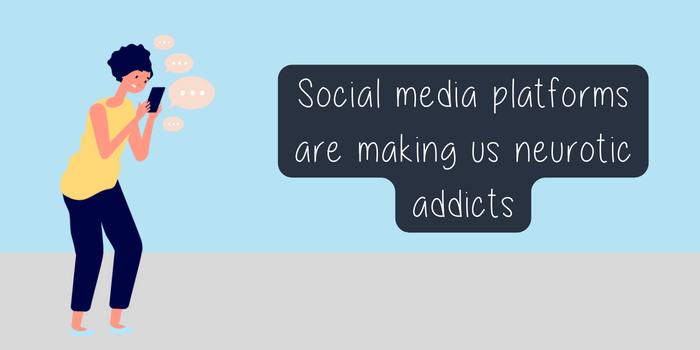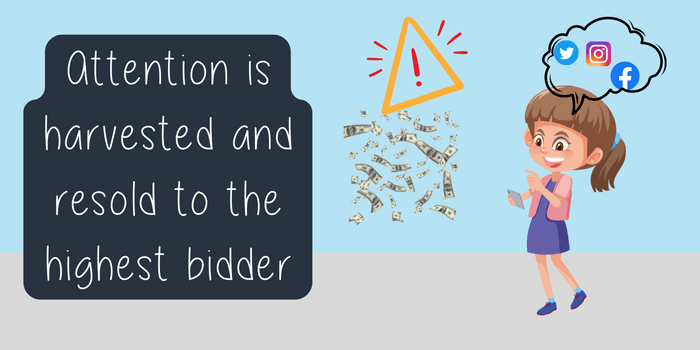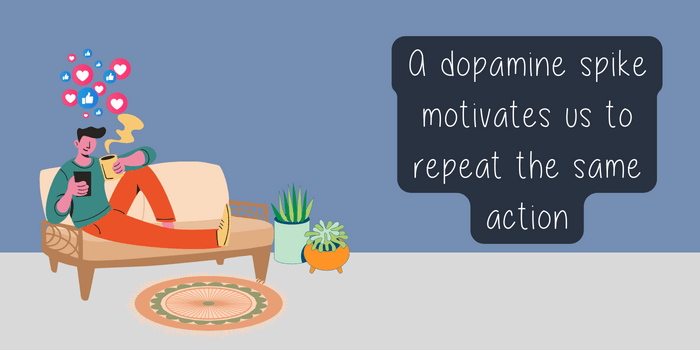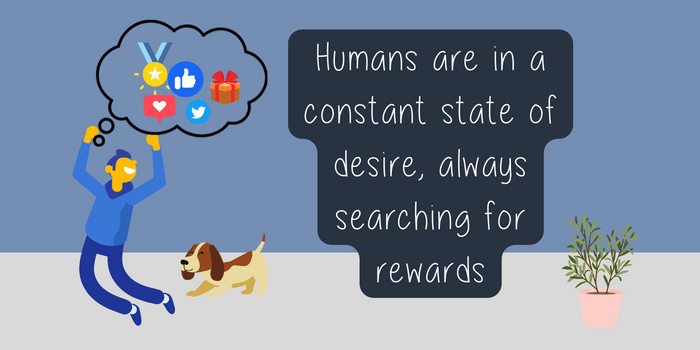Silicon Valley venture capital investor, Chamath Palihapitiya, was one of the early senior executives at Facebook between 2007-2011. As the head of Growth, he was responsible for acquiring new users to Facebook.
In an interview at the Stanford School of Business, he admitted feeling tremendous guilt for having “created tools that are ripping apart the social fabric of how society works.”
Palihapitiya talked about something that most of us know in our gut, but few really absorb. Social media platforms and the smartphones that bring them to us are actively and deliberately turning us all into neurotic addicts looking for yet another dopamine fix.
The problem though is that smartphones are great. They’re everything to us because they make life so much easier.
The internet is clearly improving our lives in countless ways. It is an immensely powerful tool at our disposal, as long as we are in control.
To gain mastery over our behaviour on the internet, we must first understand what’s going on backstage. Learn how we are susceptible and how we can protect ourselves from succumbing to its dark side.
What happens behind the scenes of big tech companies? What exactly are they doing that makes someone like Palihapitiya feel guilty?
Let’s see how, if we’re not careful, we can unwittingly become pawns in this game that is rigged against our brain.
The attention economy wants control over your mind
It was the Nobel prize winning economist, Herbert A. Simon, who first coined the term attention economy. He said that attention was the bottleneck of human thought, and what limits our understanding and our actions [1].
During much of human history, food and the land to grow food were scarce resources. With the industrial revolution, we were able to use machines to help cultivate more than enough food. What was scarce then was labour – trained people to operate machines. For several years, society was organized around labour – what knowledge or training you had, who you worked for, and what you earned.
Now we have an abundance of land, labour, and information. What is scarce now is our attention.
And this is why we are bombarded with advertisements, no matter where we look. Ads become progressively more nonsensical, weirder, and more creative, all with the single objective of capturing our attention.
Kim Kardarshian does a photoshoot that “breaks” the internet because it captures attention. The internet did not break, but your brain did, just a tiny bit. These tiny breaks and fractures rewire the brain and change your behaviour.
Whoever owns attention is king in this economy. In the fierce competition to capture attention, social media companies are the current reigning champions.
Attention Heist: How they steal your attention
In January 2010, Steve Jobs launched the first iPad. For a full 90 minutes, he talked about how it was a wonderful device that could do just about anything you wanted.
But in a later interview with New York Times journalist Nick Bilton, Jobs revealed that his kids had never used the iPad. “Actually we don’t allow the iPad in the home. We think it’s too dangerous for them in effect,” he said.
Alexis Ohanian, cofounder of Reddit, said he wants his daughter “to be bored” and hence will regulate screen time heavily.
What do these technologists know that we don’t?
Once you have an iPad in front of you, you have access to several apps and platforms that were specifically designed to be highly addictive. Anyone is susceptible to the charms of a magical device that never lets you get bored.
Sean Parker, the founding president of Facebook candidly admitted that Facebook and applications like it are designed with the specific intent of consuming “as much of your time and conscious attention as possible.”
Rewarding the pleasure centres of the brain
Apps hijack attention by rewarding the brain’s pleasure centres by hacking our social validation feedback loops. It’s a deliberate exploitation of the most basic vulnerability of human beings – the desire to be acknowledged and seen by others.
Every time someone likes or comments on your post you get a dopamine hit, which makes you want to post more, spend more time online, comment on others’ posts expecting them to reciprocate and so on.
Such admission by top execs at social media companies should give you pause.
This is real.
Companies are literally spending billions of dollars in research to keep you on their platform for as long as possible and to capture your time and attention, so they can sell it later for advertising revenue.
Social networking sites, gaming sites, news websites etc. all profit from our attention. Tim Wu, author and legal scholar, calls them attention merchants, in his book with the same title.
The modus operandi of an attention mechant is to first reel us in with free stuff, harvest our attention, and then resell it to the highest bidder. Smartphones and tablets are state of the art harvesting tools which suck our attention round the clock – it is always harvest season.
Competition is fierce in the attention economy. Everyone wants your attention, and therefore will do whatever it takes to get it.
Automatic vs controlled attention
According to cognitive psychology, we have two modes of attention [2]
- Automatic attention
- Controlled attention
Automatic attention is an evolutionary survival mechanism which scans the environment for events that are salient to staying alive, happy, and comfortable. It is reflexive, unintentional, and does not involve any effort.
Controlled attention involves deliberate thinking with intent. It takes effort.
Attention merchants want to harvest your automatic attention; and therefore the stimuli or messages they put before you invariably gravitate towards the most lurid, titillating, and outrageous.
This explains the popularity of click-baits, celebrity gossip, sensationalism, and titles like “The 42 Most Disturbing Things Of All Time” or “Girl Proposed To Her Boyfriend, You Won’t Believe What Happened Next.”
These are the sort of stimuli that our automatic attention will unthinkingly and happily process.
Race to the bottom of the brain stem
Tristan Harris, former Google Design Ethicist, calls it the “race to the bottom of the brain stem” when attention merchants do whatever it takes to extract our attention. We all contribute to and participate in this devolution of our culture to the realm of the primitive.
The quality of attention is irrelevant. What matters is just the attention – the most valuable asset in this economy.
As long as our attention remains the raw material in the business model for revenue creation, we are going to be collectively entranced and our attention harvested with no thought to what is left behind.
Addiction secrets: How to hook someone with dopamine
Human beings have evolved to be social creatures.
Evolutionarily, we needed the protection of our tribe to stay alive. We craved to connect with and contribute to our tribe, because if we were thrown out it meant almost certain death when we were out in the savannah.
The attention economy taps into this peculiar weakness of the human brain by providing a hypersocial environment within our smartphones.
Dopamine rewards
Dopamine is a type of neurotransmitter produced by our brain whenever we indulge in something pleasurable – like having delicious food or having a successful social interaction [3].
Evolutionarily speaking, these are behaviours that are beneficial for our continued survival. So a spike of dopamine after the behaviour motivates us to perform the same action again.
There are four major dopamine pathways in the brain
- Mesocortical
- Mesolimbic
- Nigrostriatal
- Tuberoinfundibular
The first 3 are reward pathways through which dopamine travels to transmit information about feelings of pleasure, sense of reward etc.
When you encounter something pleasurable, the reward pathways become active, reinforcing the association between the behaviour and the pleasurable reward that follows. This motivates you to perform the action again, because you want the pleasurable reward again.
As more and more stimuli result in reward, associations in the reward pathways become stronger. The brain also starts responding to the stimuli with more intensity, anticipating the reward.
Social interactions that are rewarding – such as recognition by our peers, people smiling at us, someone expressing interest in us – are all powerful stimuli that activate the reward pathways.
The rewards hiding in our smartphone
Inside our smartphones, we have an abundance of social stimuli.
Every time we get a message from a friend, a heart on our Instagram picture, or a like on our Facebook post, the positive social stimulus activates our reward pathways and floods us with dopamine.
Ah… bliss!
Like Pavolv’s dog, we attach this feeling of pleasure to our smartphone. In neuroscience parlance, this would be called cue-dependent learning, where the cue is the smartphone and the learning is that it is something that gives you pleasure.
Even when we’re busy with other activities, the very presence of the smartphone near us is a conditioned cue that releases dopamine in anticipation, before the reward itself.
Dr. Anna Lembke explains in her book Dopamine Nation, that the brain has a baseline level of dopamine firing even in the absence of a specific reward.
Right after a conditioned cue (looking at the smartphone), dopamine decreases to below baseline levels. This mini-deficit state of dopamine creates craving, which translates into purposeful activity to do whatever it takes to increase the dopamine level (open the phone and check for messages).
If we get the expected reward (someone has liked our post), we get an even bigger spike. If the expected reward does not materialize (no likes), then we experience an even bigger plunge.
Neuroscientists have studied this behaviour in cocaine-addicted rats where dopamine is released in response to the conditioned cue, the fall to the deficit state, and then the spike.
With smartphones, we behave just like these rats. The measure of how addicted a rat (or human) is depends on how far it is willing to work to obtain the reward.
Variable rewards: Get them craving for more
In his book Hooked: How to Build Habit-Forming Products, Nir Eyal explains how tech companies use Harvard psychologist B.F. Skinner’s study on variable rewards to increase your sense of anticipation.
Skinner observed that lab mice inside an operant conditioning chamber (Skinner’s box) responded most compulsively to unpredictable treats or rewards that appeared when they pressed a lever. As compared to mice that got the treats predictably, those whose treats were unpredictable turned out to be more compulsive lever pressers.
With unpredictability built into social media platforms (we may or may not get a like or comment), we’re trapped in this trance-like state where, much like the lab mice compulsively pressing the lever, we compulsively check the smartphone hoping for a reward.
In a constant state of desire
Human beings have the astonishing ability to keep searching for a reward, with dopamine levels kept high in anticipation. Once the dopamine starts firing, monkeys and humans will work relentlessly to get a treat at the end, Dr. Robert Sapolsky explains.
The trick though is to strike a balance. If the unpredictable reward system accumulates too many negative outcomes, we lose motivation because of frequent plunges in dopamine levels and we disengage. But a surge of positive outcomes after a series of negative ones will keep us hooked forever.
How Instagram uses variable rewards
Ramsay Brown, cofounder of Dopamine Labs, explains in this interview how Instagram withholds likes on your posts for a while, only to deliver them in a big burst later at the right moment.
When you post a picture, you may be disappointed initially by the lack of likes and the dopamine plunges low. The Instagram algorithm predicts the right moment to give you the likes, thus strongly rewarding the dopamine centers that were craving the high.
This sudden influx of social validation creates the right balance of positive and negative dopamine firing, thus turning us into habitual users.
This and other similar algorithms are employed by Instagram, Facebook, Twitter, and the like, who have the best behaviour design engineers on their team.
Do we even have a fighting chance?
Are we totally screwed?
Not really.
What you read above is what goes on behind the scenes. Now you’re aware and informed.
It may seem like we’re fighting against very powerful forces, but remember that our brain is more powerful if we know how to engage it and use it to our advantage.
Excessive smartphone usage is basically a habit that you have formed. Like any habit, it can be reset and we can rewire our brains.
Modern technology is amazing and we should not give it up. We must use our smartphones to stay in touch with friends and family, but at the same time we must also maintain a healthy relationship with the smartphone where we don’t get too obsessed with it.
In the next few articles in this series, we will expand more on building focus and reclaiming our attention from the attention merchants.
Knowing what to do is not enough. You must take the right sequence of actions at the right time to overcome deeply entrenched negative behaviours and completely rewire your brain. At HabitStrong, we have created a whole bootcamp to help you do just that.
In our 4-week online bootcamp, Undistractable — Digital Detox, we handhold you through the exact steps to create a healthy and mindful relationship with your devices.
For now, just do this for starters. Activate the Digital Wellbeing app on your smartphone and track your daily digital usage. You may be surprised by what you find.
***
Sources
[1] https://econreview.berkeley.edu/paying-attention-the-attention-economy/
[2] http://psychology.iresearchnet.com/social-psychology/social-cognition/attention/
[3] https://www.frontiersin.org/articles/10.3389/fnbeh.2010.00022/







